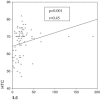Does polycythemia affect interleukin-6 response pattern in early postnatal period?
- PMID: 20872570
- PMCID: PMC6647637
- DOI: 10.1002/jcla.20413
Does polycythemia affect interleukin-6 response pattern in early postnatal period?
Abstract
Introduction: Neonatal polycythemia may result in increased cytokine production. We aimed to investigate whether polycythemia and partial exchange transfusion (PET) affect interleukin-6 (IL-6) response pattern in early neonatal period.
Methods: Ninety-four newborns, 57 with polycythemia (Group 1) and 37 as control group (Group 2) were enrolled in the study. PET was performed at 4-6 hr following birth in the first group. Blood levels of IL-6 were measured at 2-4 hr following birth; measurements were repeated at 6 and 24 hr after PET in newborns with polycythemia and at similar hours in Group 2. In Group 1, two patients (3.5%) who were diagnosed with proven sepsis excluded from the study.
Results: Both initial and the last IL-6 levels were higher in Group 1 (21.7; 5.5-190 pg/ml and 18.3; 2.7-92.4 pg/ml) than those of the controls (8.4; 0.2-47.8 pg/ml and 8.6; 2.0-21.0 pg/ml) (P=0.001 for both comparisons). In Group 1, IL-6 levels increased at 6 hr after PET and decreased thereafter. IL-6 showed the same pattern in the control group. IL-6 levels were higher than >70 pg/ml in two (3.6%), seven (12.7%), and two (3.6%) subjects during three evaluation steps, respectively. Neither clinical nor proven sepsis was subsequently detected in any of these subjects. IL-6 levels were within the acceptable values in Group 2.
Conclusion: IL-6 levels seem to be high in newborns with polycythemia during the first days of life, although they rarely exceed maximum acceptable levels. The pattern of IL-6 response might be taken into account to optimize its use in the diagnosis of early-onset neonatal sepsis.
J. Clin. Lab. Anal. 24:340-347, 2010. © 2010 Wiley-Liss, Inc.
Figures



Similar articles
-
Elevated Interleukin-6 Levels as a Potential Marker of Neonatal Morbidity in Full-term Infants With Polycythemia: A Prospective Study.J Pediatr Hematol Oncol. 2025 Jan 1;47(1):e15-e18. doi: 10.1097/MPH.0000000000002968. Epub 2024 Nov 8. J Pediatr Hematol Oncol. 2025. PMID: 39530770
-
Serum Endocan, Neuron-Specific Enolase and Ischemia-Modified Albumin Levels in Newborns with Partial Blood Exchange Transfusion.Comb Chem High Throughput Screen. 2021;24(6):825-830. doi: 10.2174/1386207323999200820163525. Comb Chem High Throughput Screen. 2021. PMID: 33109054
-
Cord blood levels of interleukin-6 and interleukin-8 for the immediate diagnosis of early-onset infection in premature infants.Biol Neonate. 2001 Aug;80(2):118-23. doi: 10.1159/000047130. Biol Neonate. 2001. PMID: 11509811
-
Plasma levels of interleukin-6 and interleukin-10 in preterm neonates evaluated for sepsis.Eur J Pediatr. 2001 Jun;160(6):345-50. doi: 10.1007/pl00008445. Eur J Pediatr. 2001. PMID: 11421413
-
Fetal and early neonatal interleukin-6 response.Cytokine. 2015 Nov;76(1):1-12. doi: 10.1016/j.cyto.2015.03.015. Epub 2015 Apr 15. Cytokine. 2015. PMID: 25890877 Review.
References
-
- Wiswell TE, Cornish JD, Northam RS. Neonatal polycythemia: Frequency of clinical manifestations and other associated findings. Pediatrics 1986;78:26–30. - PubMed
-
- Sarkar S, Rosenkrantz TS. Neonatal polycythemia and hyperviscosity. Semin Fetal Neonatal Med 2008;13:248–255. - PubMed
-
- Gomella TL, Cunningham ND, Eyal FG, Zenk KE. editors. A Lange Clinical Manual Neonatology, 5th edition New York: McGraw‐Hill; 2004. p 295–297.
-
- Black VD, Lubchenco LO. Neonatal polycythemia and hyperviscosity In: Rudolph AM, editor. Rudolph's Pediatrics, 20th edition Stamford, CT: Appleton & Lange; 1996.. p 252.
-
- Wickenhauser C, Thiele J, Lorenzen J, et al. Polycythemia vera megakaryocytes but not megakaryocytes from normal controls and patients with smokers polyglobuly spontaneously express IL‐6 and IL‐6R and secrete IL‐6. Leukemia 1999;13:327–334. - PubMed
MeSH terms
Substances
LinkOut - more resources
Full Text Sources

